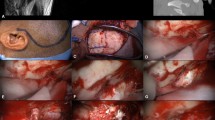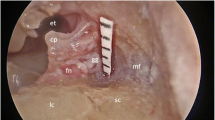Abstract
Purpose
The aim of this study is to evaluate the feasibility and the safety of a novel, alternative method for bone tissue management in facial nerve decompression by a middle cranial fossa approach.
Several applications of Piezosurgery technology have been described, and the technique has recently been extended to otologic surgery. The piezoelectric device is a bone dissector which, using micro-vibration, preserves the anatomic integrity of soft tissue thanks to a selective action on mineralized tissue.
Methods
An anatomic dissection study was conducted on fresh-frozen adult cadaveric heads. Facial nerve decompression was performed by a middle cranial fossa approach in all specimens using the piezoelectric device under a surgical 3D exoscope visualization. After the procedures, the temporal bones were examined for evidence of any injury to the facial nerve or the cochleovestibular organs.
Results
In all cases, it was possible to perform a safe dissection of the greater petrosal superficial nerve, the geniculate ganglion, and the labyrinthine tract of the facial nerve. No cases of semicircular canal, cochlea, or nerve damage were observed. All of the dissections were carried out with the ultrasonic device without the necessity to replace it with an otological drill.
Conclusion
From this preliminary study, surgical decompression of the facial nerve via the middle cranial fossa approach using Piezosurgery seems to be a safe and feasible procedure. Further cadaveric training is recommended before intraoperative use, and a wider case series is required to make a comparison with conventional devices.




Similar content being viewed by others
References
Salami A, Dellepiane M, Proto E, Mora R (2009) Piezosurgery in otologic surgery: four years of experience. Otolaryngol Head Neck Surg 140(3):412–418
da Franca Pereira MA, Bittencourt AG, de Andrade EM, Bento RF, de Brito R (2016) Decompression of the tympanic and labyrinthine segments of the facial nerve by middle cranial fossa approach: an anatomic study. Acta Neurochir 158(6):1205–1211
Salami A, Dellepiane M, Salzano FA, Mora R (2009) Piezosurgery in endoscopic dacryocystorhinostomy. Otolaryngol Head Neck Surg 140(2):264–266
Salami A, Dellepiane M, Crippa B, Mora R (2010) A new method for osteotomies in oncologic nasal surgery: piezosurgery. Am J Otolaryngol 31(3):150–153
Mirza AA, Alandejani TA, Al-Sayed AA (2020) Piezosurgery versus conventional osteotomy in rhinoplasty: a systematic review and meta-analysis. Laryngoscope 130(5):1158–1165
Meller C, Havas TE (2017) Piezoelectric technology in otolaryngology, and head and neck surgery: a review. J Laryngol Otol 131(S2):S12–S18
Lyutenski S, Bloching M (2020) Piezosurgery in translabyrinthine-approach exposure of the internal auditory canal. Otol Neurotol 41(4):554–559
Pawlowski KS, Koulich E, Cuda D et al (2011) Effects of cochlear drilling with piezosurgery medical device in rats. Laryngoscope 121(1):182–186
Cuda D, Murri A, Mochi P, Solenghi T, Tinelli N (2009) Microdrill, CO2-laser, and piezoelectric stapedotomy: a comparative study. Otol Neurotol 30(8):1111–1115
Crippa B, Dellepiane M, Mora R, Salami A (2010) Stapedotomy with and without piezosurgery: 4 years’ experience. J Otolaryngol Head Neck Surg 39(2):108–114
Samy RN, Krishnamoorthy K, Pensak ML (2007) Use of a novel ultrasonic surgical system for decompression of the facial nerve. Laryngoscope 117(5):872–875
Salami A, Mora R, Mora F et al (2010) Learning curve for piezosurgery in well-trained otological surgeons. Otolaryngol Head Neck Surg 142(1):120–125
Funding
The present authors have no financial relationship to disclose.
Author information
Authors and Affiliations
Contributions
All of the authors have read and approved the manuscript.
Corresponding author
Additional information
Publisher's Note
Springer Nature remains neutral with regard to jurisdictional claims in published maps and institutional affiliations.
Rights and permissions
About this article
Cite this article
Marchioni, D., Laura, E. & Rubini, A. Decompression of the geniculate ganglion and labyrinthine segments of the facial nerve through a middle cranial fossa approach using an ultrasonic surgical system: an anatomic study. Eur Arch Otorhinolaryngol 279, 2777–2782 (2022). https://doi.org/10.1007/s00405-021-06966-4
Received:
Accepted:
Published:
Issue Date:
DOI: https://doi.org/10.1007/s00405-021-06966-4




